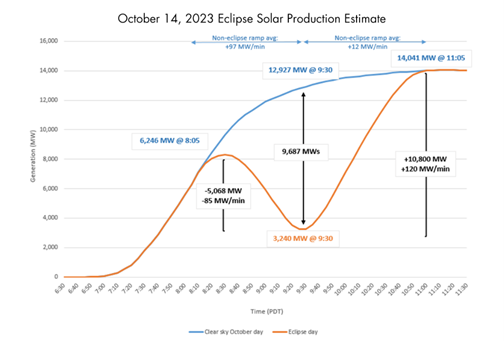News
better business decisions
Posted 2 years ago | 4 minute read

Solar eclipse’s and the impact on power grids
On October 14, 2023, an annular solar eclipse will cross over the western United States, blocking up to 90% of the sun. What does this mean for our power grid?
According to an analysis of the eclipse, the total solar eclipse that crossed through the United States in 2017, which blocked the entire sun from view along its peak path, had minimal impact as natural gas and hydropower resources ramped up to compensate for the loss of solar generation. But solar energy capacity is much higher now with some 113GW of utility-scale and distributed solar generation capacity.
The exact timing and percent of obscuration will vary with location relative to the eclipse path but the eclipse will last for approximately three hours, beginning at 8 a.m. Pacific Daylight Time (PDT) and will reach its maximum obscuration at 9:30a.m.
California, with its commitment to renewable energy sources, has one of the most extensive solar power installations in the United States. In an article published late September the grid operator said within the ISO area since the 2017 eclipse, grid-scale and rooftop behind-the-meter (BTM) solar capacity have grown by about 65% and 150% respectively. And other Western states have significantly increased their solar capacity over that same time period. This means that the upcoming eclipse will have a larger impact on the ISO and most of the 21 WEIM participants compared to the 2017 event.
Assuming clear-sky conditions at the time of the eclipse maximum, the grid-scale solar output will be reduced by 9,687MW, or about a 75% of our usual available capacity, compared to a sunny October day at the same time. From the eclipse maximum to the eclipse end, solar production will increase by 10,800MW over the course of 90 minutes. This is an increase of about 120MW of grid-scale solar per minute — 10 times the normal rate of solar increase, or ramp.
Demand will also be affected by the reduction in solar generation, which will lead to an unusual dual morning peak on the eclipse day. Following the typical morning peak around 7:00 a.m., the ISO load will increase by 2,343 MW as the eclipse reaches its maximum.

Source: CAISO
To manage the grid CAISO has said it will:
- Grid-scale solar resources will utilize specialized procedures to manage eclipse ramping requirements. The specialized solar procedures include the potential to limit the solar generation ramp rate during the return of the eclipse, in addition to utilizing an Operating Instruction (OI) for the fleet to ensure solar resources are following their Dispatch Operating Target (DOT) and linearly ramping from Dispatch Operating Point (DOP) to DOP. Much of the success of the 2017 eclipse event was due to the accuracy with which solar generation was forecasted in the day-ahead (DA) timeframe, which limited the need for real-time redispatch.
- Ensure coordination with hydro and battery resources to safeguard availability to assist with large ramps expected on the system during the eclipse. Similar to the growth of solar since 2017, CAISO has had significant growth in battery resources to assist with the faster ramping needs on the system, and the CAISO plans to utilize battery and hydro resources during the solar eclipse.
- Procure additional operating reserve requirements to assist during the eclipse. During the 2017 eclipse, additional reserve procurement helped grid operators handle resource deviation in addition to large ramps on the system. For 2023, the CAISO will procure additional operating reserve requirements to assist with the planned movement in solar generation, in addition to the potential for cloud cover to impact the system
- Complete an analysis on how the grid handles the partial eclipse for more advanced preparation of the total solar eclipse on April 8, 2024.
In Texas, which is also in the path of the eclipse, ERCOT has said it will be closely monitoring the state’s power grid during the solar eclipse as the event will pose a brand new test for the grid.
GridBeyond Chief Product Officer and President North America Sean McEvoy said:
“As we continue adding solar energy to the grid in an effort to decarbonize the power sector it is essential that we strengthen resilience through technologies and programs that help maintain power during disruptions like eclipses. For example co-locating solar-plus-storage technologies will enable more people to benefit from solar energy, even when the sun isn’t shining—even if just for a moment during an eclipse.
Microgrids also have the potential to operate autonomously from the main grid during face of service interruptions, which can also be applied to respond to eclipse conditions. But most importantly it is critical that grid operators and market participants use advanced forecasting to ensure they are prepared to minimize disruptions to their power supply.”






